I wasn’t in a good shape when I broke the sparrowhawk’s wings.
A gray sky over Berlin, a cold eastern wind. An early March day that never had properly lighted up and already started to sink back into dawn. No rain, no snow, but this dry and uncomfortable wind. I was cycling back towards my flat. The gusts came from the North-East and hit me from the right side. They had blown over the great gray Northern European plain, rushing along all the way under the same gray and somber sky, from Kiyv, from the Dnieper floodplain, where now was a war. A war, black smoke rising, shells falling and bursting, under this same bleak cloud cover which stretched far over flat plains.
The wind broke through my clothes on the bicycle and made me shiver. I was slowly pedalling back from the COVID test station, hoping that I finally tested negative and could resume life with others. It was the third time I’ve had a Coronavirus infection this winter. They had come one after the other, like grey clouds rolling in from a cold sky. I progressed slowly on the bike, trying to make the necessary effort as less fatiguing for my muscles as I could. I hoped to get a test clearance, as I had to teach my seminar later, but I still felt weak and sickly. I had to breathe hard when I tried to accelerate the bike to more than pedestrian speed.
Then came the crash. A gray shadow, a streak of energized air in a faint vibrating gray which I barely noticed in the split second I perceived it, and then the impact, the splintering sound, the noise of thick feathers brutally brushed back and scrunched up, the awareness of a sudden resistance to the rotation of my bike’s front wheel. I stopped violently, bending over forward, but managed to halt.
I looked around me. There were two bird’s bodies lying in the middle of the crossing between two side streets, two heaps of gray-brownish feathers, two beings totally strange to the tarmac they were suddenly thrown on, the gale ruffling their feathers in gusts. I did not understand immediately what had happened. I did not see clearly. I saw the feathers and knew “bird”, I saw them lying on the street and thought “hurt”, and I also thought “beauty” — a shining kind of beauty by the way these beings were misplaced on the coarse asphalt. Two feathery heaps burning holes into the shell of reality, making me glimpse what is behind it. Those presences were the truth. And they were in a terrible state.
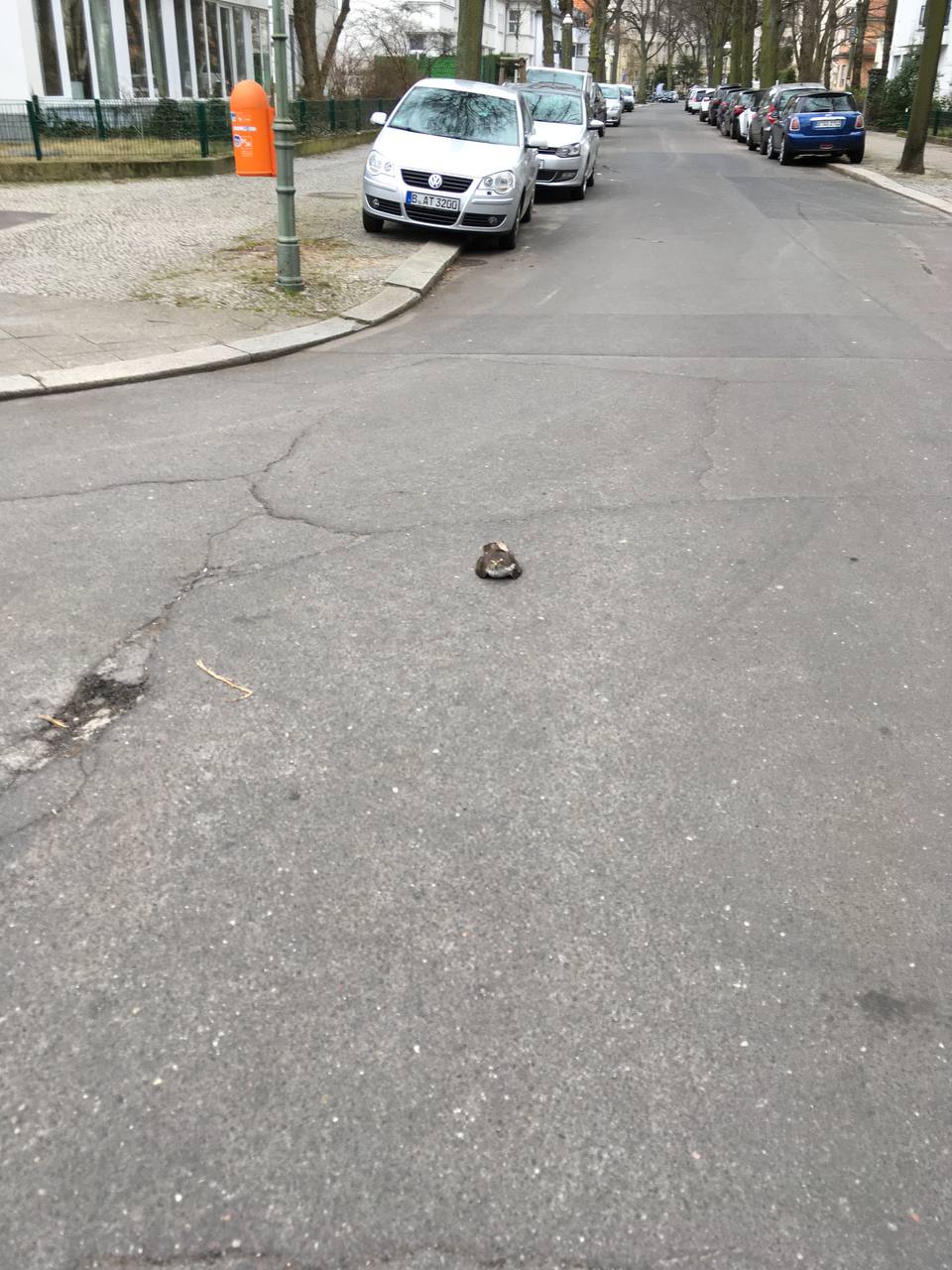
After my perception had adapted, I understood that the brown-grayish feathery thing close to me was a sparrow. It was dead. I saw the soft, gray and slightly pinkish lid over the eye which pointed to the sky, like a delicate veil which had shuttered the sight in the moment of impact, forever. I looked further down the street to the other bird. I only then realized what had happened. The second lump of feathers had somewhat reorganized and now sat flat on the street, looking at me.
It was a sparrowhawk. I understood it immediately now I saw her sitting. A female sparrowhawk. The plumage on her breast shone in a pattern of alternating black-and-white stripes. The upper side was tawny, dark brown on lighter brown and grey. She was in the middle of the road and looked at me. She held me in her gaze, in the radiant beam of two orange eyes which fixated me on the tarmac as though I was her prey — and not was she mine.
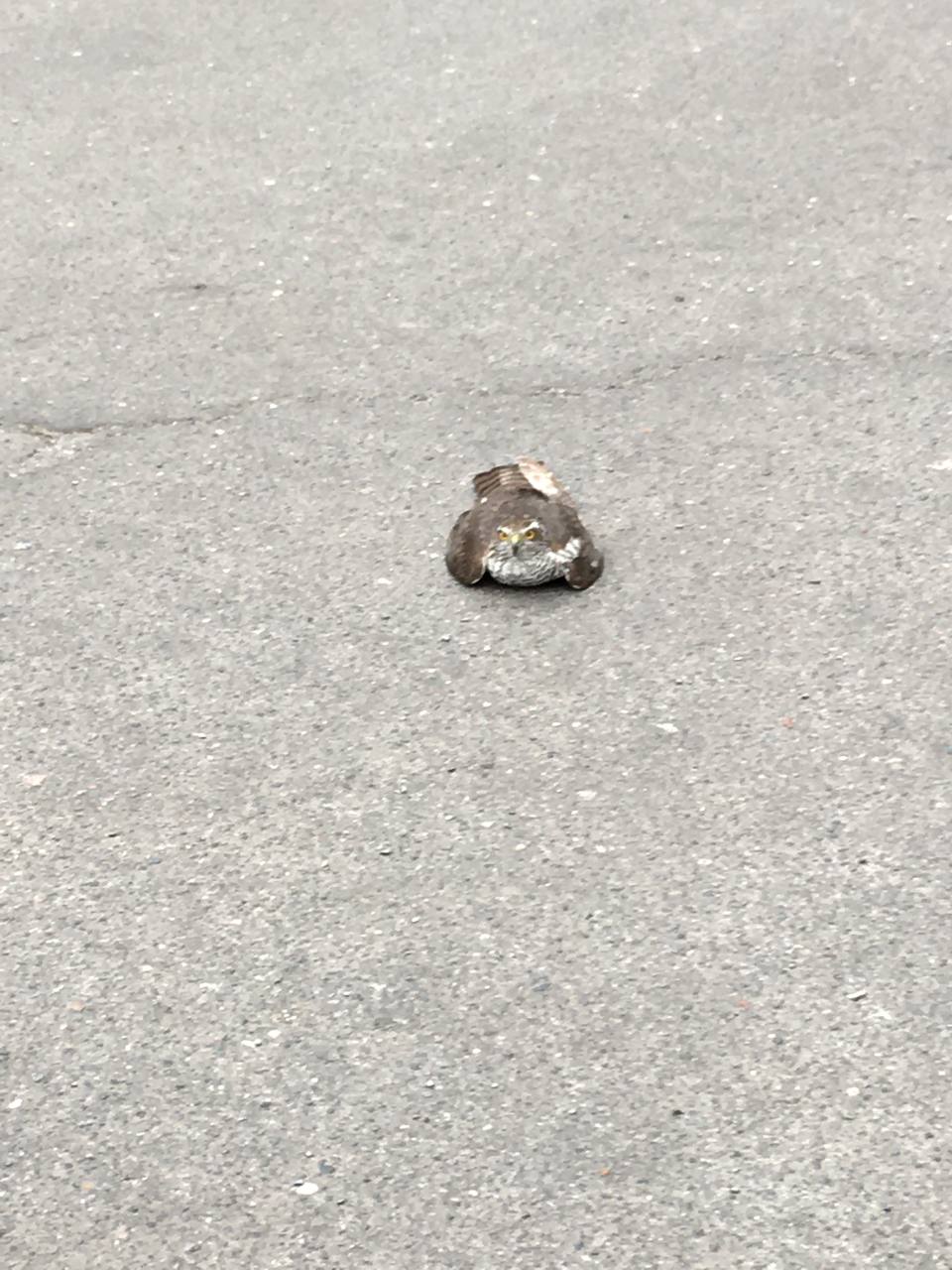
I pushed my bicycle to the post of a streetlamp at the curb. A car rolled into the intersection, and I wildly waved my arms in order to make them avoid the bird squatting in their way. The sparrowhawk still looked at me. So far, she had been motionless, hunkering low on the street. That she was alive was only manifest in her eyes, but there her aliveness was intense. The orange glow sent a beam of power into the world and made it glisten with every turn of her head. I was in its center, held in focus by an ancestral power. That was the most prominent experience: I was held in this power. And, then again, the bird sat flat on the street, clearly injured, probably in great pain, helpless.
My fingers shook when I fumbled the phone out of my pocket. I typed “Sparrowhawk injured emergency” in the search box and added “Nabu”, the acronym for “Naturschutzbund”, the name of a major nature protection NGO. I remembered that they run a wildlife sanctuary in the capital. I already had dropped a bird there: My son once brought a tiny warbler chick home from his way back from school. When I opened the door, he said: “Bad news. I have a little bird which fell out of the nest.” We gave the nestling the wrong food first, so the staff scolded us, but they managed to nurse the chick back to health.
“I have injured a sparrowhawk”, I told the lady who picked up the phone. Another lady, I thought, being up to doing tedious volunteer work with birds.
“Does she have a ring?” she asked.
“I can’t see. She is sitting on her belly.”
“Can you catch her?”
“Catch?”
“I can’t come to get her.”
I looked at the bird. Right now, she started to flutter. Her wings made a whirring and flapping noise and she slid some feet across the tarmac.
“I don’t know”, I said. “She is trying to escape.”
“If you manage, it would be great. If you don’t, then it is just as it is. There are many more migrant sparrowhawks from the northeast right now in Berlin”, the lady said.
Migrants from the northeast, I thought. Raptors arriving from Russia, from the Baltics, from Ukraine. In my imagination, I heard the splintering noise again when the birds had crashed into the whirring spokes of my front wheel. I felt nauseous. Bombs dropped in the northeast, splintering wood, shredding concrete, tearing up bodies. The sparrowhawk possibly had come from those regions. Then he crashed into my bike, in a scene of violence. Violence, suddenly exploding around her, around me. The dead sparrow on the street. The devastated hawk. My hands still slightly shook. I would not leave her here.
“Ok”, I said.
“Bring her to the university vet clinic if you manage to catch her. They treat injured wild birds.”
The sparrowhawk started to flutter again. Another car passed by, slowly curving around the bird who was now anxious to get away, but unable to fly. Two young men approached, as out of nowhere, and walked by, slowly, staring at the bird.
“Do you live nearby?” I asked the older one.
“Yeah. We’re just about to move house.”
“Could you help me catch the bird?”
“Oh sure. What bird is it?”
“A sparrowhawk.”
“A what?”
Obviously, he had never heard the name — the name of the second-frequent raptor on the Eurasian landmass, after the buzzard. But he was eager to help, as was his mate. They dashed off and came back moments later with a large moving box. In the meantime, I had searched for the location of a nearby sharing car on my phone. When the two young men were there again and I looked up, excited, and vibrating with the faint hope that this might not end with the death of this bird of prey, the sparrowhawk was gone.
“Where is she?” the older guy shouted.
“I think under that car”, I said, getting down on my knees, staring into the dark interstice between metal and road.
But there was no bird.
Sparrowhawks are in many respects lesser goshawks — a miniature version of their bigger cousins, just as buzzards are smaller-scale editions of golden eagles. Just like some model trains which both come in scale 0 and the smaller 00, the pairs look pretty similar, apart from their body size. Sparrowhawks and goshawks also have pretty close habits of hunting. Both are originally forest dwellers and are capable of maneuvering the dense stands of trees with incredibly speedy flight. Birds process on average three times more pictures per second than we do — for sparrowhawks a Netflix episode would be composed of a series of stills – and so are able to avoid crashing into obstacles.
At least the goshawk mostly manages — the smaller sparrowhawk is known for sometimes giving away security for a bigger impact of the attack. In Berlin, the Nabu folk know that they occasionally smash into glass fronts while they persecute small songbirds. They crash into cars — or bicycles. Human-made obstacles are far more destructive than naturally grown ones — like trees or foliage. Human-made objects are in the way of the sparrowhawks’ prime hunting asset: brutal speed and the willingness to risk it all.
The raptor usually waits hidden in a bush and then suddenly sweeps out of it, accelerates with frantic beats of his wedge-shaped wings up to 50 kilometers per hour, mostly only two or three feet overground, and then tries to capture the small songbird she had observed and singled out. All this happens so swiftly, in such a casually determined way, that most people rarely or never see a sparrowhawk. It is as though the bird’s body while hunting completely transformed into immaterial energy, a flash, an arrow made from light, and no longer a visible animal.
But, in spite of all this shapeshifting magic, on average, only every tenth attack is successful. That means that in times of dwindling bird numbers (because of crashing insect quantities), hunting becomes harder for the daring predator – and accordingly more dangerous.
“The bird is here”, one of the guys shouted. Somehow, she had made it across the street and into a corner at the bottom of a wall behind some bushes. She wanted to escape us, all her force pulled her to search for a protected hiding place and to sit there in the dark and to wait until the pain would go, until she could stretch her wings again, until she could stand on her sturdy, yellow feet with the sharp claws, until she could fly again and hunt, sweep down as a deadly gust from the top of a barren tree between two gray buildings and crash into a flock of sparrows, beating down her prey from the empty air and flying away with it.
I only hoped she would make it to the clinic. Unwillingly, she had maneuvered herself into the perfect spot the catch her. We just needed to push the box to the wall. Somehow, she slid in, beating her flight feathers hard against the container. I tilted the box over and closed the lid. Her claws made a scraping noise on the floor. I lifted the package up. The bird was lighter than I had expected.
The car was just around the corner. I put the box with the raptor in his cardboard shelter on the back seat, typed a message to the college that I’d be late to my seminar this afternoon, and started the engine.
Like many creatures of the silent wild who have become exiled from their lives in today’s agro-savannas devoid of wild corners and refuges for life, sparrowhawks are adapting to a life in cities. They hunt smaller birds and indeed predominantly feed on sparrows. In Berlin, those often roost in bushes in front of condominiums, fed by elderly women who rejoice in hearing the little singers’ chatter in front of their double glass windows. In the German capital, bird ecologists estimate that about fifty breeding pairs of sparrowhawks raise offspring every year.
In winter, their numbers are reinforced by wandering visitors from those parts of northern and eastern Europe where the cold season is still too inhospitable for them to survive. Then those reckless hunters from the dense spruce forests of the great northeastern plains have to maneuver between parking cars, whirring rental scooters, and bulky buses. And still, nearly nobody sees them. Only when the lesser bird folk starts their shrill alarm calls, we can glean that there might be a sparrowhawk planning an ambush.
The bird scratched the cardboard from time to time. I wondered which body parts had been damaged in the impact. At least one wing. Maybe both. Possibly also a leg. Or both. She did not stand; she lay stretched out on the floor. But maybe birds can’t stand with one wing hanging down. I sensed the muffled noises from the cardboard and hoped that she was not hurting too badly. I drove fast. I had the impression I was doing some sort of ambulance service. And then the students were also waiting for me. When the red light flashed in my face, I knew that I had gotten a speeding ticket. Plus, the extra fee the car-sharing company would demand.
I sped on, eager to give this being back its full life. My heart was low. The world seemed somber. There was this terrible war that had just started, and now I had destroyed a beautiful bird of prey. It felt gloomy and distorted. And somehow those two facts belonged together. I had not even been fast. I had had no chance to avoid the impact. Both birds only manifested in the moment when they shattered into my wheel. Before they had been invisible, they had been on the plane of a spiritual duel, somewhere in the land where only unseen forces act, where nothing had a fixed shape, where everything waits in order to burst into being.
The two birds had burst into disaster. And I was the one to be struck with it, to receive the message.
I thought of the dead sparrow. I had put it under the hedge behind the streetlight to which my bike was locked. I thought of the closed eye under its tender membrane. I realized that I had not paid much attention to this casualty. It did not feel fair. Sparrows are much more numerous than birds of prey (although their numbers are in decline, too), and somehow seem less remarkable as individuals. But I knew immediately that this was only what it seemed. A life is a life, and this one was over.
And then I thought of the day I had hit a sparrowhawk hunting sparrows before, and also caused a casualty. I had not thought of it before, so quickly had I had to act today. But now the memory struck me and gave me sudden gooseflesh. Today was not the first time I had run into a hunt in full flight. I knew all this already.
That other time was late January afternoon, on a bank of the Pò River in northern Italy. We slowly rolled through the thickening fog in our car. The stream lay gray and silent to the right, behind lone groups of bushes and trees. When a couple of shadows darted from the nothingness towards my windscreen, I had no chance to react, just as it had been today. A small bird hit the glass with a thump. For a fraction of a second, I saw the fleeting silhouette of some other little birds and the curved wedge of a sparrowhawk pursuing the chase.
I stopped. The sparrow lay in the brown leaves of the embankment, between the barren stalks and the withered dishes of last summer’s wild carrot blossoms. He looked at me, the black eye on his side wide open. He was breathing wildly and frantically, but not moving at all. He just looked at me, petrified, shaken by his breath. I took up the tiny animal with my hand. I felt his little heart racing. Still, he just stared at me. I feared he would die at any moment, would draw that soft veil over his eye and stop breathing. But he did not.
I put him into the low vegetation where a barren branch and some dense stalks formed a sort of natural platform, a kind of nest actually. I did not want him to lie on the ground. He still stared, silent, panting. I left him there, parked the car, and we walked some steps. The fog was closing fast, dusk fell, and the plain and the wide stream merged into one all-encompassing grey plain. Only the trees and plant stems provided some vertical movement, gave a low rhythm to the blurred landscape.
We turned back quickly. The air was moist and chilly. As I passed the little platform I had put the sparrow on, I could see that he was still there, eyes open. I went closer. And then, in this moment, he flew, rose up with the weightlessness of a creature of the sky, beating the wings a couple of times and then soaring, beating and soaring, fully back in the shape of his own aliveness, radiating life in every gesture of his undulating flight until he vanished in the fog towards the river Pò.
At the clinic, I did not need to wait. A young man, a vet student obviously, asked me to fill out a form. “Do not try to call and ask how the animal you delivered fares as we have far too much to do to be able to tell you”, it read in bold capital letters on the lower part. When I had marked my address and some more details, I pushed the cardboard box over the counter. Through an open door, I could see persons in green and blue surgical gear moving between stainless steel surfaces.
The sparrowhawk made a scratching noise when the student took the box. “You’re good,” he told me. “There is nothing more to do.” I walked out into the gray day and went slowly towards the parked car, under a low northeastern sky which was heavy on my body. It weighed me down like unbearably doleful news.
Andreas Weber
Berlin

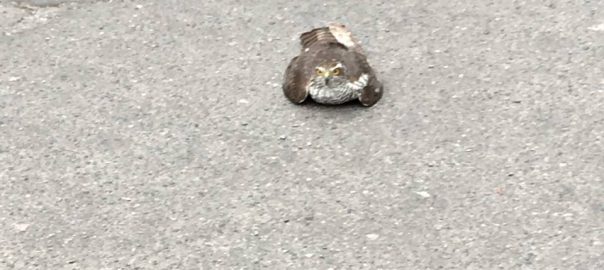






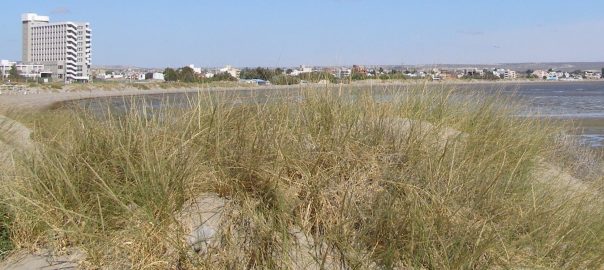
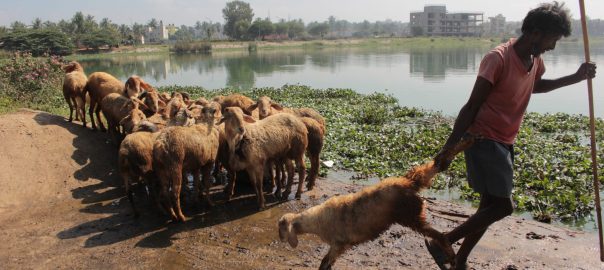
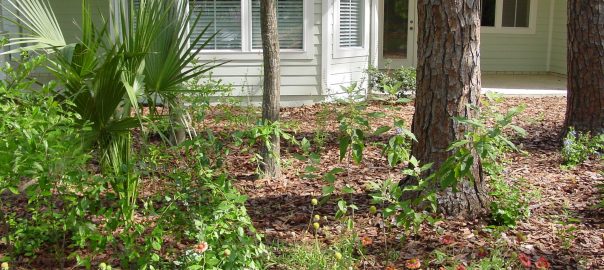
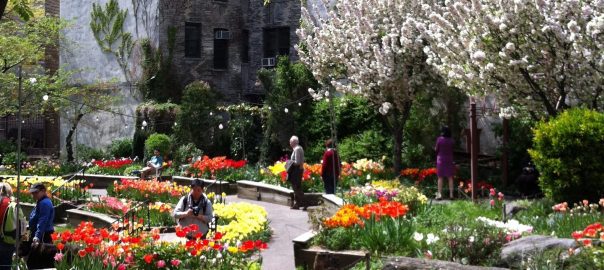
Add a Comment
Join our conversation